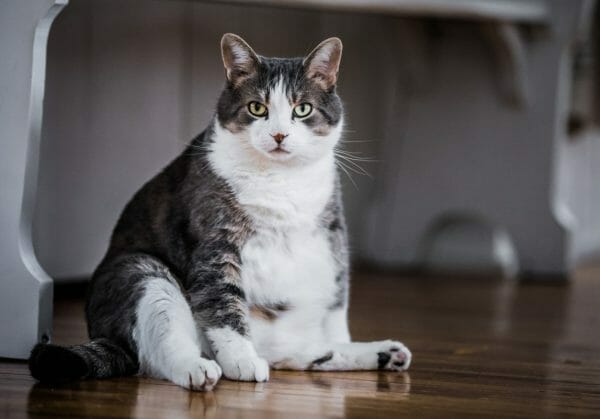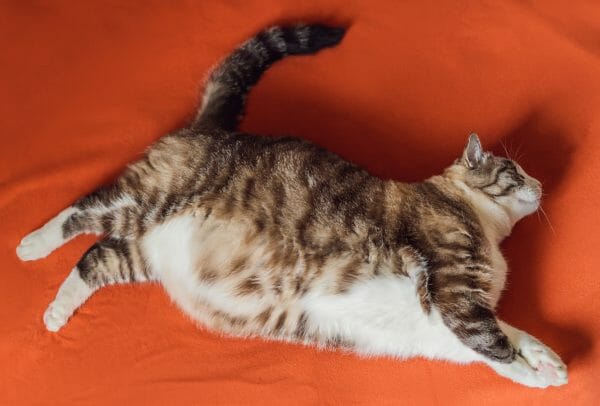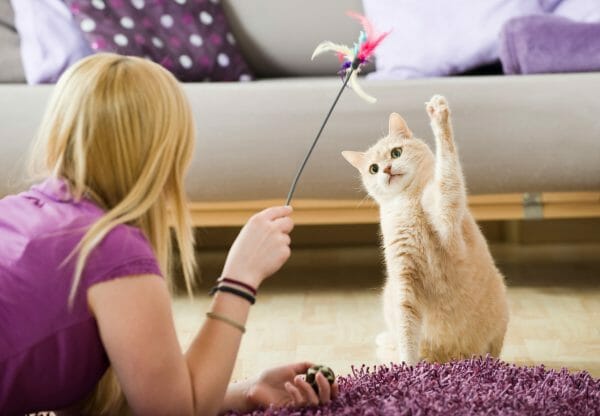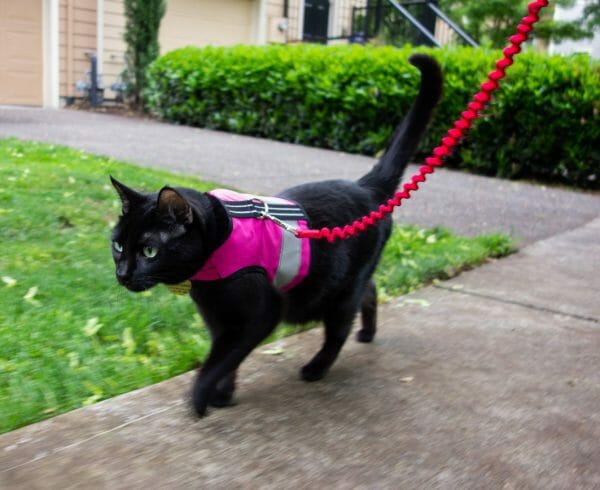What Is Obesity in Cats?
The cat obesity rate in the United States is between 30% and 35%. In addition, almost half of cats between the ages of 5 and 11 are overweight or classified as obese. An obese cat is a feline that weighs 20% or more over its ideal body weight. An overweight cat weighs 10% to 20% more than its ideal body weight. The general definition of obesity is an accumulation of excess body fat.
Obese cats tend to be middle-aged, neutered, and male. Indoor cats are more likely to be obese than outdoor cats. Felines are at greater risk of becoming overweight after being spayed or neutered.
On average, most cats should weigh between 7 to 12 pounds, depending on their breed and frame. For example, certain breeds—such as the Maine Coon—have a higher ideal weight. (A healthy weight for a Maine Coon cat is between 12 and 18 pounds.)

Cat Obesity Chart
Many pet owners may wonder “Is my cat obese?” There is no set “obese cat weight” because a feline’s weight will vary depending on several factors, such as their sex, breed, and frame. Instead, veterinarians determine whether a cat is obese using a feline obesity chart called the Body Condition Scoring (BCS) Chart.
The Body Condition Scoring Chart has a scale from 1 to 9, with 1 being a cat that is too skinny and 9 being a morbidly obese cat. A cat rated a 5 is at its ideal weight. The Body Condition Scoring Chart features illustrations of cats from the side and the top, as well as verbal descriptions. Here are some of the descriptions for cats based on the chart prepared by the World Small Animal Veterinary Association (WSAVA):
- Rating of 1/9: Severely Underweight: The ribs are easily seen, and no fat pads are visible. The spine and hip bones are obvious, and the cat has a severe abdominal tuck.
- Rating 3/9: Underweight: The ribs are easily felt with minimal fat covering. The spine is obvious, as is the waist behind the ribs. Minimal abdominal fat pads are present.
- Rating 5/9: Ideal Weight: A cat with an ideal weight is well-proportioned. The ribs can be felt under a slight fat covering, and the waist can be seen behind the ribs but is not pronounced. There are minimal abdominal fat pads.
- Rating 7/9: Overweight: The ribs are not easily felt and have a moderate fat covering. The waist is not easily seen, and the abdomen may be slightly rounded. The cat has a moderate abdominal fat pad.
- Rating 9/9: Obese: The ribs cannot be easily felt and are covered with heavy fat. Heavy fat deposits are found around the spine, face, and limbs. The abdomen is distended. The cat has no waist and dense abdominal fat deposits.

Indicators of Obesity in Cats
Although Body Condition Scoring charts are available online for feline owners to perform their own assessments, other signs of an obese cat include:
- A swinging pouch between a cat’s hind legs
- Greasy or matted fur down the middle of a cat’s lower back—an indicator that the feline may be unable to groom this area
- Snoring or wheezing
- No waistline (indentation behind the ribs) when looking down on the cat
- Inability to feel the cat’s ribs
What Causes Obesity in Cats?
Feline obesity can have medical causes or may be caused by overeating and lack of exercise. Medical causes for feline obesity include hypothyroidism, hyperadrenocorticism (Cushing’s Disease), insulinoma, and spaying/neutering.
However, obesity in cats is most often caused by overfeeding and lack of exercise. In these cases, the cat takes in more calories than it expends. “Free feeding”—in which dry food is available throughout the day—is one of the major causes of obese cats. Other contributing factors include frequent treats, high-calorie foods, and lack of exercise.

Risk Factors Associated with Obese Cats
An obese cat is at risk for multiple health problems, including:
- Skin infections
- High blood pressure
- Heart disease
- Diabetes mellitus
- Some types of cancer
- Osteoarthritis
- Hip dysplasia
- Urinary bladder stones
- Difficulty combating infectious diseases.
Because of the increased propensity to the medical issues listed above, obesity in cats shortens their life expectancy. Obese cats also face increased risks with anesthesia and chronic inflammation. In short, feline obesity affects a cat’s health in a multitude of ways.

Managing Feline Obesity
Fortunately, cat obesity is treatable. The first order of business is to visit a veterinarian to develop a plan of action that focuses on weight loss and increased exercise. It is not safe to simply feed a cat less. This can lead to malnourishment and a condition called hepatic lipidosis. Instead, a veterinarian can suggest a new feeding and exercise plan based on the specific needs of the cat, especially if the obesity is caused by a medical condition.
Weight Loss Strategies for Cats
As with humans, weight loss strategies for cats involve slow and gradual weight loss that is monitored regularly. A safe weight loss rate for cats is 1.5% of their body weight until the ideal weight is reached.
Depending on the cat’s specific needs, the vet may prescribe special food for obese cats, such as Hill’s Prescription Diet Metabolic, Royal Canin Satiety Support Weight Management, and Purina Overweight Management. These foods are scientifically formulated with lower calories but with an appropriate balance of nutrients.
Some basics for weight loss diets for cats include the following guidelines.
- Feed cats only at specified meal times. This means stopping “free feeding” and converting to “meal only” feeding. Meal frequency will be determined by a vet. In some cases, the vet may recommend feeding a cat smaller portions but more frequently.
- Portion control is critical. The vet will provide appropriate measurements for the food that the cat should eat, as well as directions on how often to feed the cat.
- Protein-rich wet foods that are high in fiber but low in fat are preferable to dry foods, which tend to be higher in calories. Wet food also has more fluids, which help a cat feel fuller.
- Reduce treats. Treats should account for less than 10% of a cat’s daily intake. Talk to the vet for guidance on cat treats that are more nutritionally balanced.
- Weigh the cat every 2 to 3 weeks. An infant scale is ideal for this purpose.
- Do not give the cat people food.
- Feed cats separately to avoid competitive eating and/or food sharing. This allows an owner to ensure that an obese cat is only eating the recommended food in the proper amounts.

Exercising Cats
In addition to putting obese cats on a monitored weight loss diet, pet owners should take steps to increase a cat’s exercise and activity levels. Begin with a goal of 10 minutes of exercise per day—gradually increasing to 30 minutes of exercise each day. Ideally, these 30 minutes will be divided into two 15-minute increments.
The Ohio State University College of Veterinary Medicine had created a list of activities for increasing a cat’s activity levels and helping owners come up with new ways of playing with their cat. Tried and true activities include laser pointers, feather teasers, cat trees, and scratching posts. Providing jingly balls and catnip-filled toys are other perennial favorites. If providing treats for a cat, consider hiding them throughout the house to encourage movement and exercise—or tie the giving of treats to the end of playtime.
Some owners walk their cats daily. However, it may take some time to acclimate the feline to a harness and leash. Chewy.com provides a guide to leash training a cat that may help take the frustration out of the process.




